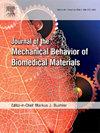Mechanical properties of stromal striae, and their impact on corneal tissue behavior
IF 3.3
2区 医学
Q2 ENGINEERING, BIOMEDICAL
Journal of the Mechanical Behavior of Biomedical Materials
Pub Date : 2024-10-12
DOI:10.1016/j.jmbbm.2024.106770
引用次数: 0
Abstract
Cornea is an essential element of our eye. The refractive power of the cornea is closely related to its shape, which depends on the balance between its mechanical properties and the intraocular pressure. However, in keratoconus, the shape of the cornea is altered, and the mechanical properties (i.e., elastic modulus and viscosity) are reduced. These alterations have been associated with the development of striae within the cornea. Recently, such striae have been observed in healthy corneas as well, but with slightly different shapes. Our study investigated the mechanical role of these striae. To this end, we performed an inflation test under Optical Coherence Tomography: tomographic volumes were acquired in the central zone of eleven human corneas during an inflation test. Striae planes were extracted from the segmented images, and principal deformation maps were obtained by Digital Volume Correlation (DVC). We observe that the pattern of the striae does not change with pressure, even far above physiological pressure. Maximum principal strains are co-localized with the striae and are oriented perpendicular to the striae. We also observe that principal deformations on the striae increase with depth in the cornea. Our results show that striae lead to greater deformability in the direction perpendicular to the striae, especially in the posterior part of the cornea where they are the most visible. This supports the idea that the striae are undulations in the cornea collagenous microstructure, which are progressively unfolded under loading. They decrease the global stiffness of the cornea, in particular in the posterior part, and thus may help in accommodating deformations.
基质条纹的机械特性及其对角膜组织行为的影响。
角膜是眼睛的重要组成部分。角膜的屈光力与角膜的形状密切相关,而角膜的形状取决于角膜的机械特性和眼内压之间的平衡。然而,角膜炎患者的角膜形状会发生改变,机械性能(即弹性模量和粘度)也会降低。这些改变与角膜内条纹的形成有关。最近,在健康角膜中也观察到了这种条纹,但形状略有不同。我们的研究调查了这些条纹的机械作用。为此,我们在光学相干断层成像技术下进行了充气测试:在充气测试过程中,我们采集了 11 个人类角膜中央区域的断层成像体积。从分割图像中提取条纹平面,并通过数字容积相关(DVC)获得主变形图。我们观察到,即使远高于生理压力,条纹的形态也不会随压力而改变。最大主应变与条纹共定位,且方向垂直于条纹。我们还观察到,条纹上的主变形随角膜深度的增加而增加。我们的结果表明,条纹会导致垂直于条纹方向的更大变形,尤其是在条纹最明显的角膜后部。这支持了一种观点,即条纹是角膜胶原微结构中的起伏,在负荷作用下逐渐展开。它们降低了角膜(尤其是后部角膜)的整体硬度,因此可能有助于适应变形。
本文章由计算机程序翻译,如有差异,请以英文原文为准。
求助全文
约1分钟内获得全文
求助全文
来源期刊

Journal of the Mechanical Behavior of Biomedical Materials
工程技术-材料科学:生物材料
CiteScore
7.20
自引率
7.70%
发文量
505
审稿时长
46 days
期刊介绍:
The Journal of the Mechanical Behavior of Biomedical Materials is concerned with the mechanical deformation, damage and failure under applied forces, of biological material (at the tissue, cellular and molecular levels) and of biomaterials, i.e. those materials which are designed to mimic or replace biological materials.
The primary focus of the journal is the synthesis of materials science, biology, and medical and dental science. Reports of fundamental scientific investigations are welcome, as are articles concerned with the practical application of materials in medical devices. Both experimental and theoretical work is of interest; theoretical papers will normally include comparison of predictions with experimental data, though we recognize that this may not always be appropriate. The journal also publishes technical notes concerned with emerging experimental or theoretical techniques, letters to the editor and, by invitation, review articles and papers describing existing techniques for the benefit of an interdisciplinary readership.
 求助内容:
求助内容: 应助结果提醒方式:
应助结果提醒方式:


